Affiliate disclosure: This post may contain affiliate links. Please see our Privacy Policy.
Farmer’s cheese is the perfect cheese for beginners because it’s easy to make and requires no special equipment. The resulting cheese is mild and creamy, with a slight lemony tang. Farmer’s cheese is versatile and can be used in place of either ricotta in recipes, or like simple cream cheese as a topping or spread.
It only takes about 30 minutes to make homemade farmer’s cheese using common ingredients. That makes it a wonderfully simple project to do with kids (or dinner guests).
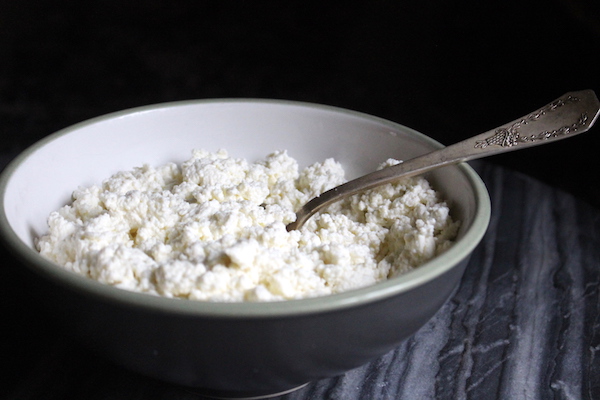
What is Farmer’s Cheese?
Farmer’s cheese is often called curd cheese because it’s a soft, unripened cheese made from strained curds. The finished cheese has a very mild lemon-y flavor from the addition of lemon juice as an acid source to coagulate the milk into curds.
Traditionally, this type of farmer’s cheese is ready quickly, in under an hour from start to finish.
There are variations that require several days to make, using cultures to form curds in the milk. While those are sometimes called “farmer’s cheese” they’re not quite the same as this simple traditional recipe. Just a name convergence because the name “farmer’s cheese” is pretty non-descript.
Farmer’s Cheese Recipe Variations
Since farmer’s cheese is a simple curd cheese that just requires a bit of acid to coagulate the milk, there are actually a number of different ways to make it. All farmer’s cheese recipes start with milk, but beyond that, they use different acidifiers to cause coagulation.
Some use just lemon juice, others use cider vinegar. A few others add heavy cream for a more ‘cream cheese’ like finished product, with higher butterfat.
This farmer’s cheese recipe comes from One Hour Cheese: Fresh and Simple Cheeses You Can Make in an Hour or Less. It uses milk, buttermilk and lemon juice along with a bit of optional salt for a more savory cheese. Both the buttermilk and the lemon juice provide acidity and flavor to the cheese.
In a pinch, you can make a farmer’s cheese without the buttermilk. Simply omit the buttermilk and use the same amount of lemon juice. The finished cheese will be more lemony since it doesn’t have the flavor of the cultured buttermilk to balance it out, but that’s not necessarily a bad thing.
Equipment for Making Farmer’s Cheese
Unlike most cheesemaking recipes that require specialized starter cultures, molds or presses this is a very low-tech cheese recipe. You will need a saucepan or pot, standard kitchen colander, and a bit of fine cheesecloth (90 grade).
Lacking cheesecloth, I’ve used a piece of cut-up cotton T-shirt or cotton napkin to strain this farmer’s cheese when making it outside my own kitchen. It’s really a very forgiving recipe and you can make it happen even in a poorly equipped dorm room kitchen.
An instant-read kitchen thermometer is also helpful, but not strictly necessary. The milk is initially heated to about 175 degrees, but up to as hot as just under 200 degrees works too. If you don’t have a thermometer, heat the milk until it’s very hot but not quite simmering yet.
How to Make Farmer’s Cheese
The first step to making farmer’s cheese is to bring the milk up to temperature. This is a quick homemade cheese, without an extended culturing time, so it’s going to start a lot warmer than many slow cultured homemade cheese recipes. Start by bringing the milk up to 175 degrees F.
This doesn’t have to be exact, and if you don’t have a thermometer that’s ok. Warm the milk to quite hot, but not simmering/boiling. Mine hit 175 degrees right as a skin started to form on the surface, so that may also be a good indicator.
Once the cheese is up to temperature, it’s time to add the acid sources. This farmer’s cheese recipe uses both cultured buttermilk and lemon juice.
The cultured buttermilk adds a lot of flavor, and I’d say it’s the dominant flavor in the finished cheese. The lemon juice adds acidity, but it’s barely detectable once the cheese is strained.
Choose an all-natural non-fat cultured buttermilk, which is to say…real buttermilk. There’s an impressive array of fake buttermilk available at the supermarket, which basically amounts to a pourable liquid yogurt made with whole milk.
That will still culture this farmer’s cheese, but it’ll have a different finished flavor. Real buttermilk is the liquid left over after churning butter, and that liquid is cultured which raises the acidity and makes it more digestible (and probiotic).
If you can’t find real buttermilk at the store for any reason, and you don’t want to spend the time churning your own butter to get buttermilk, you can try culturing milk with real buttermilk cultures. Cultures for Health has a guide with a few ways to make your own buttermilk that will work when substituted into this recipe.
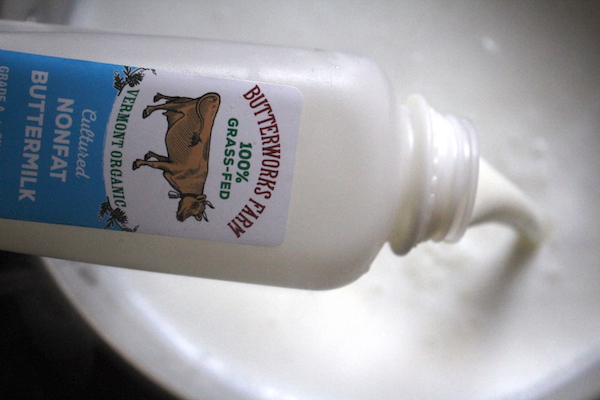
While the choice of buttermilk is important to the finished farmer’s cheese flavor, the lemon juice you use is less important. You can use fresh lemon juice, or bottled lemon juice, no matter. Fresh will likely add a bit more lemon flavor to the finished cheese, and canned lemon juice has a more neutral flavor.
You can also add citric acid to acidify the cheese, which will add acid without the lemon flavor. To substitute citric acid for lemon juice in this recipe, use 1/4 tsp powdered citric acid in place of each tablespoon of lemon juice.
In my case, I happened to have a bit of home-canned lemon juice on hand from when citrus was on sale this winter. I added a few tablespoons of that to curdle this farmer’s cheese.
After adding buttermilk and lemon juice, give the pot a stir to distribute the acid sources and then allow the pot to sit undisturbed for 5 minutes. The farmer’s cheese should begin to form curds immediately, but give it the full 5 minutes to allow them to firm up before straining.
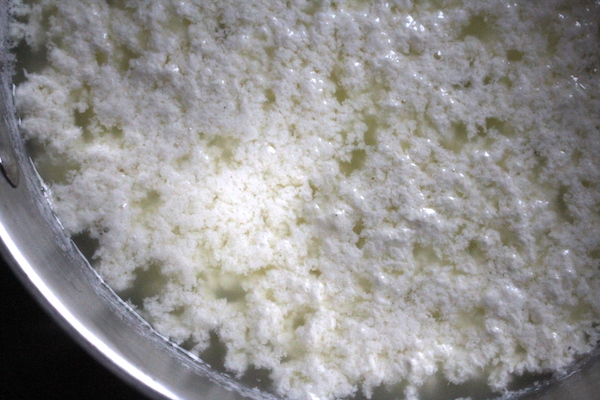
After waiting 5 minutes, pour the curds and whey through a colander lined with fine cheesecloth. Allow the cheese to stand in the colander for 2-3 minutes (or longer for a much dryer cheese).
I wanted mine a bit on the dryer side, so I bundled up the cheesecloth and gave it a squeeze to push out more whey. Less straining time will give you a much wetter cheese, a bit closer to cottage cheese.
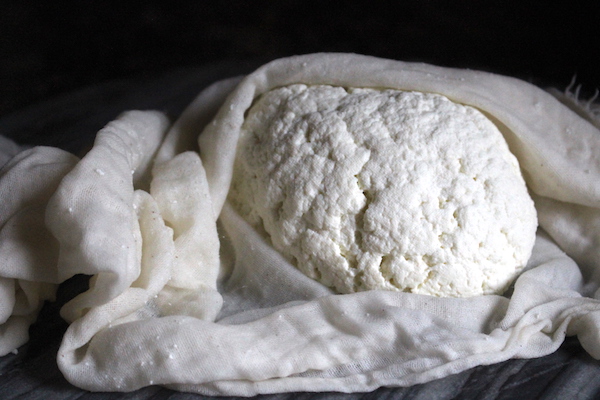
How to Use Farmer’s Cheese
After straining, farmer’s cheese is generally crumbled up and stored in a tub. Often it’s called “lazy man’s ricotta” because it’s a very similar cheese flavor-wise. To make the texture more moist and creamy, add about a tablespoon of heavy cream to the crumbled farmer’s cheese and then you might not be able to tell quick homemade farmer’s cheese from regular whole milk ricotta.
Farmer’s cheese can be used in both sweet and savory recipes, in place of either ricotta or cream cheese. Try making a cheesecake using a traditional ricotta cheesecake recipe, or use it as a filling for stuffed shells along with herbs.
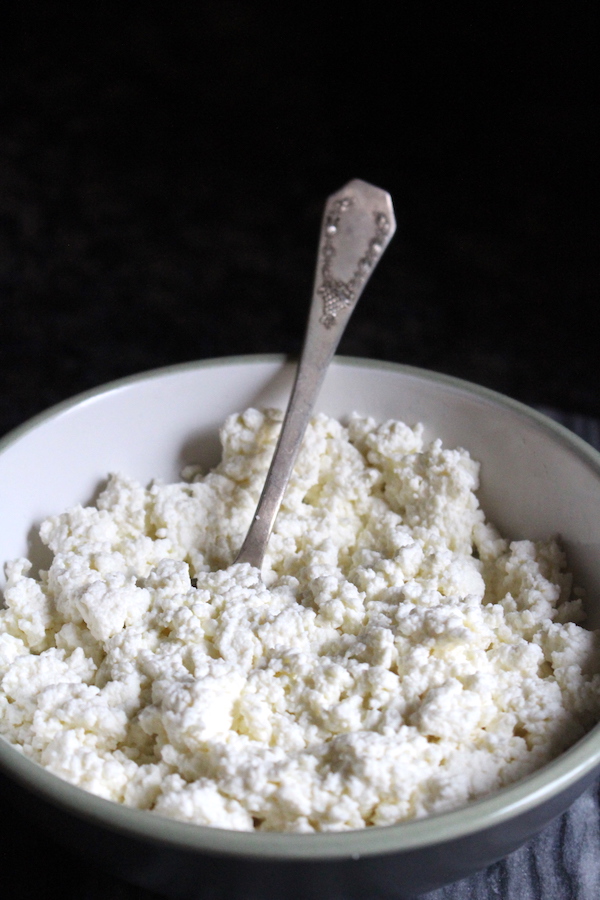
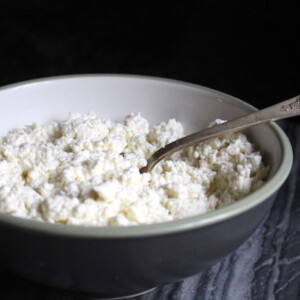
Farmer's Cheese
Ingredients
- 1/2 gallon whole milk, Raw or Pasteurized, but not ultra-pasteurized
- 2 cups cultured buttermilk
- 4 tbsp lemon juice, fresh or bottled
- 1/2 tsp sea salt, optional, to taste
- Fresh herbs, minced (optional)
Instructions
- Pour the milk into a pot and heat over medium heat to 175 degrees. Stir as necessary to prevent scorching, and turn the heat down it it begins to stick to the bottom of the pan.
- Turn off the heat and add buttermilk and lemon juice, stirring to incorporate.
- The milk should begin to form curds immediately, but allow it to sit undisturbed for at least 5 minutes. At this point, you should see a clear separation of curds and whey.
- Pour the curds and whey into a cheesecloth lined colander. Allow the curds to drain for 2-3 minutes, until they look like a thick oatmeal. (Drain longer for a dryer finished cheese).
- Stir in salt and herbs (optional, if using) and serve.
More Easy Cheesemaking Recipes
Looking for more inspiration to keep the curds flowing? Try any of these beginning cheesemaking recipes:
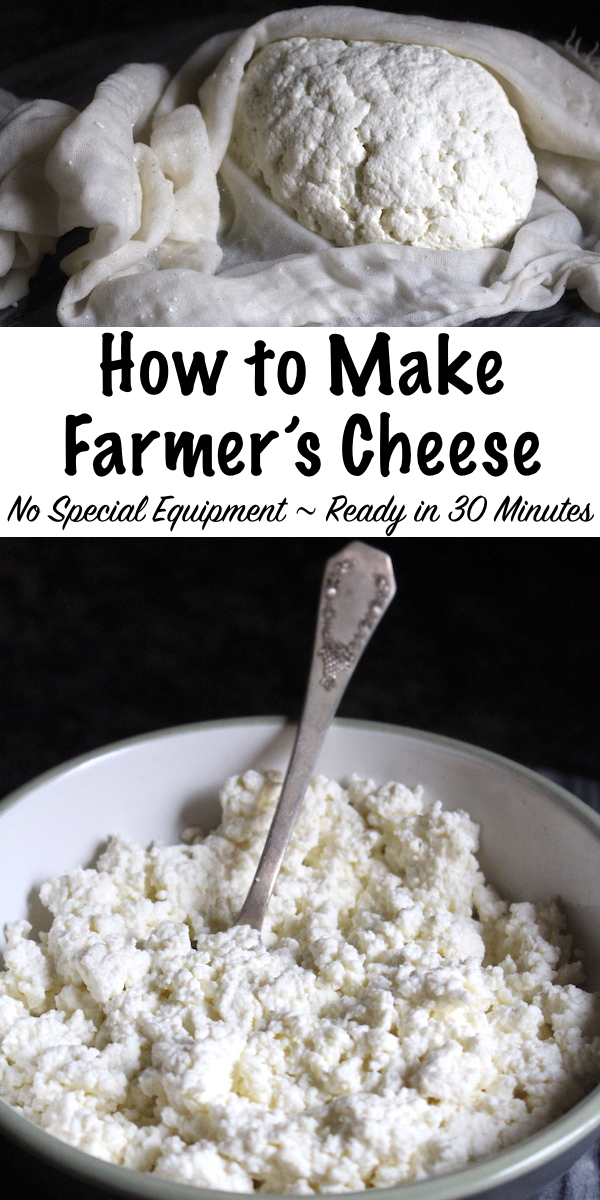
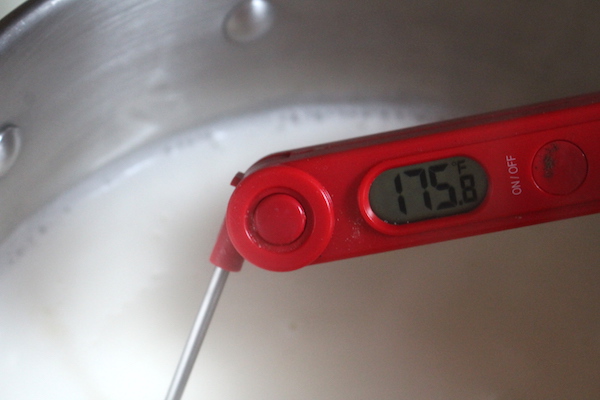



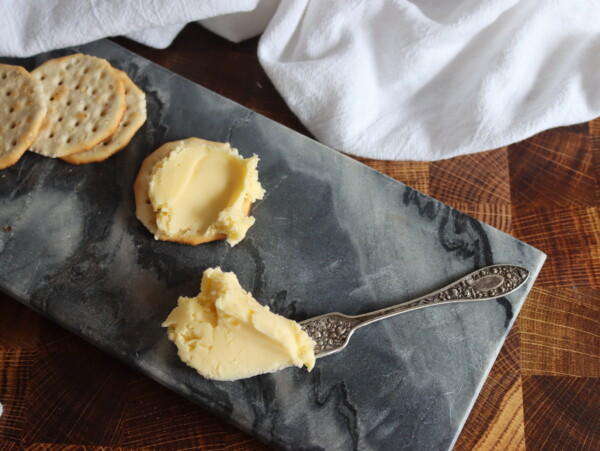
The easiest way to make farmer’s cheese is to simply let a jar of raw milk sit on the counter for a few days. Then it separates into curds and whey. Strain the whey from the curds with cheesecloth, then you have farmer’s cheese! No need to buy any store-bought fake buttermilk with GMO yeasts.
Traditional dairy products are made with raw milk and it’s really unfortunate how many people don’t use raw milk now and therefore don’t know what all the terms actually mean (like buttermilk is simply the milk that separates from the fat when making butter, it’s not what you buy at the store).
Raw milk is so important to health and how our animals and ecosystems are treated. The Untold Story of Milk is a great book to understand why raw milk is illegal in many states now. It will likely make you want to support a local farmer and get in on a milk share!
Instead of buttermilk could I use kefir?
I have seen recipes for Farmer’s Cheese with kefir before. I haven’t tried it with this exact recipe though. If you decide to try it, let us know how it goes.
If I want a rich and more fatty cheese, can I add heavy cream to the milk and how much?
I haven’t tried that but you’re welcome to experiment with it. I would just try adding a little bit at a time and just keep your total liquid the same amount.
What can I do with the whey after?? Hoping there’s some way to not waste that!
Here is a great article from New England Cheesemaking Company about ways to use whey.
https://cheesemaking.com/blogs/fun-along-the-whey/using-that-leftover-whey
Could I use plain whole milk kefir in place of the buttermilk?
Yes you can.
Can I use my homemade kefir instead of buttermilk?
Yes, it should work just fine with kefir.
Can Greek yogurt ne used instead of buttermilk?
There is a variation of farmer’s cheese that is made with greek yogurt called tvorog. If you do an internet search for farmer’s cheese made with greek yogurt, you should find several recipes.
Can you make this dairy free by using almond milk (or full fat coconut milk) instead of whole milk?
Cultures for health has some tips on their website for making cultures with non-dairy milks.
Can you turn Farmers Cheese into Cottage Cheese. If so HOW. LOL
Can I make the cheese just from buttermilk???
Unfortunately, no. The acid in buttermilk is what initiates the process of turning whole milk into curds.
how much cheese results? (by ounce)
thx
It will make about six ounces.
I used ultra-pasterized milk on accident cuz I didn’t realize that’s what I bought and it still came out great!! Excellent recipe, super easy!!
Yay! I’m so glad!
I keep a powdered form of cultured buttermilk on hand as I dont use it often. Would this be acceptable to use in a reconstituted form instead of buttermilk?
That is a good question, and honestly I don’t know the answer because I have no idea if the cultures are still live (just dormant) in the powdered form. Maybe try it and see? I think it might work, but I can’t say for sure. Let me know how it goes!
I tried this over the weekend and it turned out great. Added it to store bought cream cheese and it made the creamiest cheesecake I’ve ever made. Thanks so much
Yummy!
thank you for this recipe, i will try and make it. .